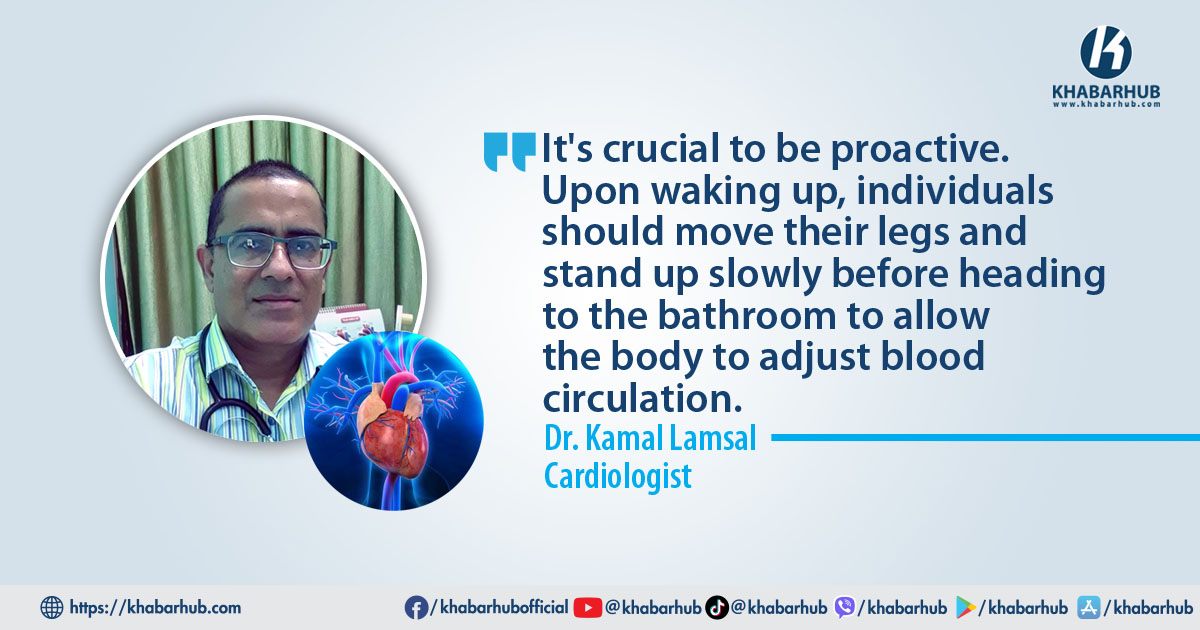KATHMANDU: In recent times, there has been a disturbing surge in reports detailing sudden deaths occurring in bathrooms, leaving friends, colleagues, and relatives shocked by the unexpected loss.
These incidents, often associated with falls, raise concerns about the prevalence of heart attacks.
Contrary to popular belief, not all bathroom-related fatalities are attributed to heart attacks.
This prompts a crucial question: Is a heart attack the underlying cause of these incidents?
Furthermore, why does this issue seem to affect men more than women?
Senior cardiologist, Dr. Kamal Lamsal, sheds light on these pressing matters.
The rise in sudden deaths following bathroom falls has sparked speculation about the involvement of heart attacks.
However, it is essential to recognize that not all cases of fainting or unconsciousness in the bathroom are linked to cardiac events.
Dr. Lamsal highlights a key factor: as individuals age, the weakening of the body’s nerves can lead to seizures, triggered by diminished blood flow to the brain.
Consequently, fainting in the bathroom may result from factors other than heart-related issues.
Additionally, individuals who have been on long-term medication for conditions such as blood pressure and diabetes may face unique risks.
Prolonged use of these medications can lead to slightly wider blood vessels. When individuals abruptly wake from sleep, a sudden drop in blood pressure may occur, causing them to faint.
The consequence of falling in the bathroom at night, often unnoticed by others, increases the likelihood of severe outcomes.
As reports of bathroom-related fatalities continue to rise, it is crucial to dispel the misconception that all such incidents are indicative of heart attacks.
Dr. Kamal Lamsal’s insights emphasize the multifaceted nature of these occurrences, urging a nuanced understanding of the underlying causes.
By shedding light on the various factors contributing to bathroom falls, we can collectively work towards mitigating these risks and promoting safety awareness in our communities.
Can you tell us which season is most likely to see a higher incidence of heart attacks in the bathroom?
Certainly. In general, the likelihood of a heart attack in the bathroom is higher during the winter season.
Cold weather tends to elevate blood pressure and increases the risk of heart-related issues, as the heart has to work harder to maintain body temperature.
We often hear about the elderly facing issues like falling and dying in the bathroom. Is this problem also prevalent among the younger population?
The issue of falling and dying in the bathroom is more common among the elderly.
However, for the younger population, a notable concern is neurination or straining during urination.
This is associated with the parasympathetic system and is more common in young people.
Moving on to a more global perspective, how does the number of deaths due to heart attacks in the bathroom in Nepal compare to other countries?
The incidence of heart attacks is on the rise in Nepal, even among the younger demographic.
This surge can be attributed to various factors, including drug consumption and lifestyle choices.
The increase is notable when compared to other countries, signifying a growing health concern.
We often hear that this problem seems more common in men than in women. Can you shed some light on why that might be the case?
Heart disease, in general, is more common in men than in women.
The increased prevalence of this issue in men can be attributed to various risk factors such as stress, smoking, and other lifestyle-related elements.
What preventive measures can individuals take to avoid such incidents in the bathroom?
It’s crucial to be proactive. Upon waking up, individuals should move their legs and stand up slowly before heading to the bathroom to allow the body to adjust blood circulation.
If someone has experienced such a problem before, it’s advisable to consult a doctor to prevent recurrence.
Additionally, for those facing difficulty urinating, sitting down can reduce the risk of injury.
Can you shed light on whether the structure of the bathroom has any impact on the occurrence of heart attacks in that space?
Absolutely. The structure of the bathroom can indeed play a role, especially concerning individuals with heart conditions.
It’s crucial to be cautious about the design. Interestingly, the act of not standing up to urinate may contribute to weight gain, which can be a concern even if someone falls.
Patients with heart problems should be mindful of their diet and lifestyle choices to mitigate the risk of heart disease.
Moving on to a different scenario, what is the recommended course of action for someone who has been involved in a physical altercation and needs medical attention?
It’s essential to get the person to the hospital as quickly as possible.
Swift medical attention is key in understanding the cause of the collapse, and appropriate treatment can be initiated accordingly.
Are there any immediate first aid measures that can be administered at home in such situations?
If a head injury is suspected, it’s crucial to seek medical attention immediately.
If the person regains consciousness promptly, monitoring blood pressure and heart rate is important.
If all vital signs are normal, the individual should rest and consume plenty of snacks.
Speaking of overall health, what suggestions do you have for the general public to prevent heart diseases, given the recent increase in their prevalence?
In light of the rising risk of heart diseases, adopting a healthy lifestyle is paramount. It’s crucial to practice what we preach to others.
Maintaining control over blood pressure, cholesterol, and sugar levels, along with paying attention to a balanced diet and regular exercise, can significantly contribute to preventing heart disease.









Comment